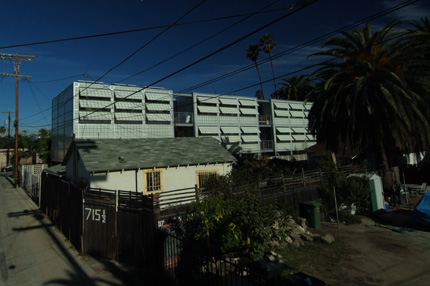
Yesterday Venice’s M Cube, a floating, minimalist apartment building by designer Mark Baez, was found by the LA City Council to be two feet above local 30-foot height restrictions and would not provide an exemption for the 2004 project. The result, Baez said, will probably be destruction of the structure.
“To fix it would cost more than it cost to erect it in the first place,” Baez said. Were he simply to lower the roof two feet, the spaces would violate the code in another way as to be uninhabitable. Baez had already agreed to remove the home’s solar panels, lowering the house from 33 feet 4 inches to 32. The neighbors, according to Baez, were all supportive of the house. But it was all to no avail.
The prefab, modular building at 709 5th Avenue in Venice has three units measuring a total of about 5,500 square feet. It glows from within thanks to exterior windows and sliding doors made of translucent fiberglass. These and other elements make the cube look like a Japanese Tatami home floating above the city. The structure also uses radiant heating which, for now, is powered by the rooftop solar panels.
The height discrepancy, which has been bouncing around the LA bureaucracy for years now, violates the Venice Coastal Specific Plan. Baez said it resulted not from disregard of city standards, but from fabrication and measurement errors and from unclear communications with the city. Part of problems arose, according to Baez, when the height was measured from the building’s alleyway, not centerline, and when fabricated parts did not match with the original schematics. “We’re still puzzled,” Baez said. (Several calls to the planning and the building and safety departments were not returned. UPDATE: Two city officials talked to AN about the issue today. See their comments here)
“Every step of the way it was signed off,” Baez added. “We didn’t do anything without approval. We were deemed 99 percent complete when the height problem was discovered.” Finally Baez tried to invoke a city rule stating that local mechanical systems could measure as high as 35 feet. The city first agreed, then reneged, he said.
“It wasn’t a shock, but we were really hoping that the right thing was going to get done,” Baez said. The architect complained that local councilman Bill Rosendahl, who had claimed to support the project, didn’t appear at the meeting. “Because he didn’t give them any direction they were forced to deny it. To approve it would mean going over his head,” Baez suggest. Rosendahl’s office did not respond to requests for comment.
“We don’t know what our options are anymore,” Baez said. He is currently conferring with his attorney to see what options he has remaining.
UPDATE 6/7: City officials respond, saying Baez failed to keep his building within clearly defined limits. Read all about it on the A|N Blog.